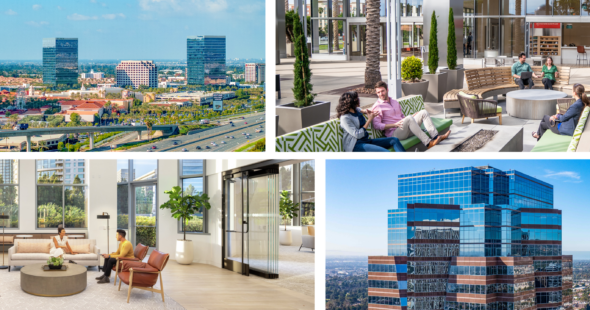IRVINE, CA—Governor Brown’s aggressive goals for doubling the energy efficiency of existing buildings by 2030 will continue to drive new technologies, Irvine Co.’s VP of energy management Rich Bluth tells GlobeSt.com. The development firm owns and operates the most ENERGY STAR-certified offices of any building owner in the nation, and three of the company’s new buildings—two at its “NextGen” Sand Canyon Business Center here and Eastgate Terrace (9779 Kettner) in La Jolla, CA—were among only 10 new developments nationwide to become “Designed to Earn the Energy STAR” certified in 2016.
Additionally, 400 Spectrum Center Dr., a 21-story campus opening this summer, has just become one of the first buildings in the nation to receive this recognition in 2017. And, the company owns the largest portfolio of Leadership in Energy & Environmental Design (LEED)-certified office buildings in California and recently launched the world’s first fleet of hybrid-electric buildings in Orange County.
We spoke with Bluth about the areas of focus in sustainability that are gaining momentum and what impact these measures are having on commercial real estate development.
GlobeSt.com: What areas of focus to you see gaining momentum?
Bluth: Gov. Jerry Brown’s aggressive goals for doubling the energy efficiency of existing buildings by 2030 will continue to drive new technologies, including application of the Internet of Things into building-system analytics in an effort to extract more energy out of their operation.
California’s Statewide Building Energy Use Disclosure Program will be in full force in about a year, requiring buildings greater than 50,000 square feet to disclose their annual energy use to the California Energy Commission. This program will apply to commercial and multifamily buildings and will bring energy efficiency even more into the forefront as the data becomes available.
The LEED-Arc program shifts LEED certifications from a five-year to an annual cycle. It also generates ongoing feedback regarding a building’s sustainability performance and provides information that can be shared with customers to encourage them to help enhance the building’s sustainability performance. We were proud to certify the first LEED-Arc office building in California last year; we now have 12 buildings certified under the program.
Irvine Co. is a leader in the growing trend of energy storage with the deployment of the world’s first fleet of hybrid-electric buildings in Orange County. With our partner, Advanced Microgrid Solutions, we are installing Tesla battery energy-storage systems at more than 20 locations. These systems, representing the electrical load equivalent of approximately 10,000 homes, will charge during nighttime hours when energy is plentiful so that it can be used during peak periods of demand to reduce stress on the electric grid.
Another area of focus is electric vehicles. Irvine Co. has installed about 400 electric-vehicle-charging ports over the past five years at locations from San Diego to Silicon Valley. We are currently serving about 2,000 unique drivers each month. So far, we have helped avoid greenhouse gas emissions that are equivalent to 2.4 million passenger-car miles.
Energy conservation and sustainability is a priority for our customers, and we continuously listen to and incorporate their feedback and ideas.
GlobeSt.com: What kind of impact are these measures having?
Bluth: They are having a big impact. As one example, Energy STAR, a program administered by the US Environmental Protection Agency, rates buildings for energy efficiency, and the trend is clear: more developers and owners in 2016 earned Energy STAR certification than ever before. On average, Energy STAR-certified buildings use 35% less energy and generate commensurately lower greenhouse=gas emissions. In the case of Irvine Co., we had 14 of our Northern California buildings certified this year, up from six last year, and our 113 certified office buildings are the most of any owner in the nation. This is great news as we try to meet the growing demand for sustainable solutions.
GlobeSt.com: How do you think the incredibly rainy season we enjoyed will impact the way commercial companies respond to calls for water conservation?
Bluth: Although the governor recently lifted the drought emergency in California, we must remain vigilant about water conservation. I expect the trend to continue toward using less potable water and more high-efficiency plumbing fixtures, smart irrigation and fertilization systems, recycled water for irrigation and drought-tolerant landscaping. Innovative conservationists and entrepreneurs will find new ways for us to use less water while enhancing the workplace experience for customers.
GlobeSt.com: What impact has the shutdown of San Onofre nuclear generating station and the impairment of the Aliso Canyon natural-gas storage facility, both located in Southern California, had on the development community?
Bluth: There’s no question we face a deepening energy shortage, and it’s a situation that demands visionary solutions. The state has mandated that by 2030 half of all electricity come from renewable sources. The closure of San Onofre and the Aliso Canyon leak have put additional stress on the situation. But I’m optimistic that if our industry continues to focus on developing creative solutions, such as our hybrid-electric buildings, our buildings will remain sustainable deep into the future, and operating them will be less impactful to the community and less expensive for building owners and their customers.
Originally published on May 4, GlobeSt.com





